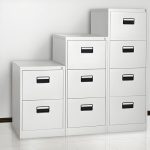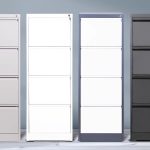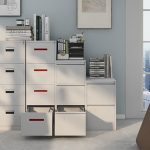When it comes to selecting filing cabinets for offices, schools, or industrial settings, durability is a non-negotiable factor. After all, these storage solutions are expected to protect critical documents, withstand daily wear and tear, and last for years without compromising functionality.
Among the most popular options, wooden and steel filing cabinets dominate the market—but which material truly offers superior longevity?
Defining “Durability”: It’s More Than Just Not Breaking
When evaluating the durability of filing cabinets, the following factors are typically considered:
- Structural Integrity: Ability to bear weight without sagging or deforming.
- Surface Durability: Resistance to scratches, dents, and daily wear.
- Longevity & Maintenance: How it ages and what upkeep it requires.
- Functional Security: Protection of contents from theft and fire.
Next, let's compare the performance of wood and steel based on these key metrics.
1. Structural Integrity & Load Capacity
Winner: Steel Filing Cabinets
This is steel’s most decisive victory. Commercial-grade steel filing cabinets are engineered to staggering weight capacities.
- Steel: Taking a double-drawer horizontal steel file cabinet as an example, each drawer can support a rated load of 150-200 pounds (68-90 kilograms). This capacity is achieved through reinforced welds, heavy-duty drawer slides, and the inherent strength of cold-rolled steel.
- Wooden: Wooden cabinets, even high-quality ones, are rarely rated for such loads. Their drawers rely on different construction methods (dovetail joints, wooden slides or lighter-duty metal slides). Overloading is a primary cause of failure. While they can handle paper, they are not suited for extreme weights.
For archives, legal documents, or any high-density storage, steel is the only professional choice. Always check the manufacturer’s weight rating spec sheet—this is a key marker of a quality cabinet.
2. Surface Durability & Damage Resistance
Winner: It’s a Tie (But for Different Reasons)
- Steel: High-quality steel cabinets feature a powder-coated or baked-on enamel finish. This makes them highly resistant to scratches, scuffs, and chemicals. However, their main weakness is dent resistance. A sharp impact can leave a permanent crease on thinner-gauge steel.
- Wooden: Solid wood cabinets can be scratched more easily. However, their supreme advantage is repairability. A deep scratch in steel is permanent. A scratch in wood can be sanded and refinished, making it look new again. Wood hides minor wear and tear more gracefully over decades.
Consider your office environment. High-traffic, utilitarian spaces (warehouses, busy hallways) benefit from steel’s scratch resistance. Executive offices and low-traffic areas are perfect for wood’s repairable beauty.
3. Longevity, Maintenance & Value Over Time
Winner: Context-Dependent
- Steel: Steel cabinets have simpler mechanics. Drawer slides can be replaced easily if worn out. A well-made steel cabinet from a reputable supplier (like Dongzhixin) will function flawlessly for 20-30 years with minimal care. The value is in its consistent performance.
- Wooden: Wooden cabinets offer aesthetic longevity. A steel cabinet can look dated; a classic oak or cherry wood cabinet remains timeless and prestigious. Its value often increases with age as a piece of furniture, whereas steel’s value is purely functional.
4. Security & Fire Protection
Winner: Steel
This is non-negotiable for securing vital documents.
- Security: Steel cabinets are built to integrate robust, commercial-grade locking systems, including central locking and integrated locks. The material itself is a physical deterrent.
- Fire Protection: This is critical. You can purchase steel cabinets with UL (Underwriters Laboratories) Classified fire ratings (e.g., 1-hour protection). These are engineered with special insulation to protect interior contents from heat. Wooden cabinets offer virtually no fire resistance and are themselves combustible.
If you are storing original contracts, employee records, or other irreplaceable documents, a fire-rated steel cabinet is not just a purchase—it’s a necessary insurance policy.
The Verdict: Steel Filing Cabinets are More Durable
For export-oriented businesses, industrial clients, or institutions requiring maximum protection, steel filing cabinets are the smarter investment. They offer:
20+ years of reliable use with minimal maintenance
Unmatched resistance to fire, water, and pests
Cost-effectiveness over time (no replacement costs from warping/rotting)
Wooden cabinets suit niche cases where aesthetics outweigh functionality, but they demand stricter upkeep and carry higher long-term risks.
Conclusion: Which Is Right for You?
Choosing between wooden and steel filing cabinets depends on your specific needs. If durability, strength, and long-term reliability are your top priorities, steel filing cabinets offer the best value. They are ideal for high-traffic environments and provide excellent protection for important documents.
On the other hand, if you prioritize aesthetics and are willing to invest in proper care and maintenance, wooden filing cabinets can add a touch of elegance to your office space. However, be mindful of their limitations in terms of durability.
At Dongzhixin Office Furniture, we offer a range of steel filing cabinets that are designed to provide maximum durability and long-lasting performance. Whether you need storage solutions for your home office or a commercial setting, our products are built to withstand the test of time.
As a trusted provider of high-quality filing cabinets, we take pride in offering products that meet the highest standards of durability and functionality. Our team of experts ensures that every steel filing cabinet we sell is tested for strength, quality, and performance. With years of experience in the industry, we are here to help you make the best choice for your storage needs.





